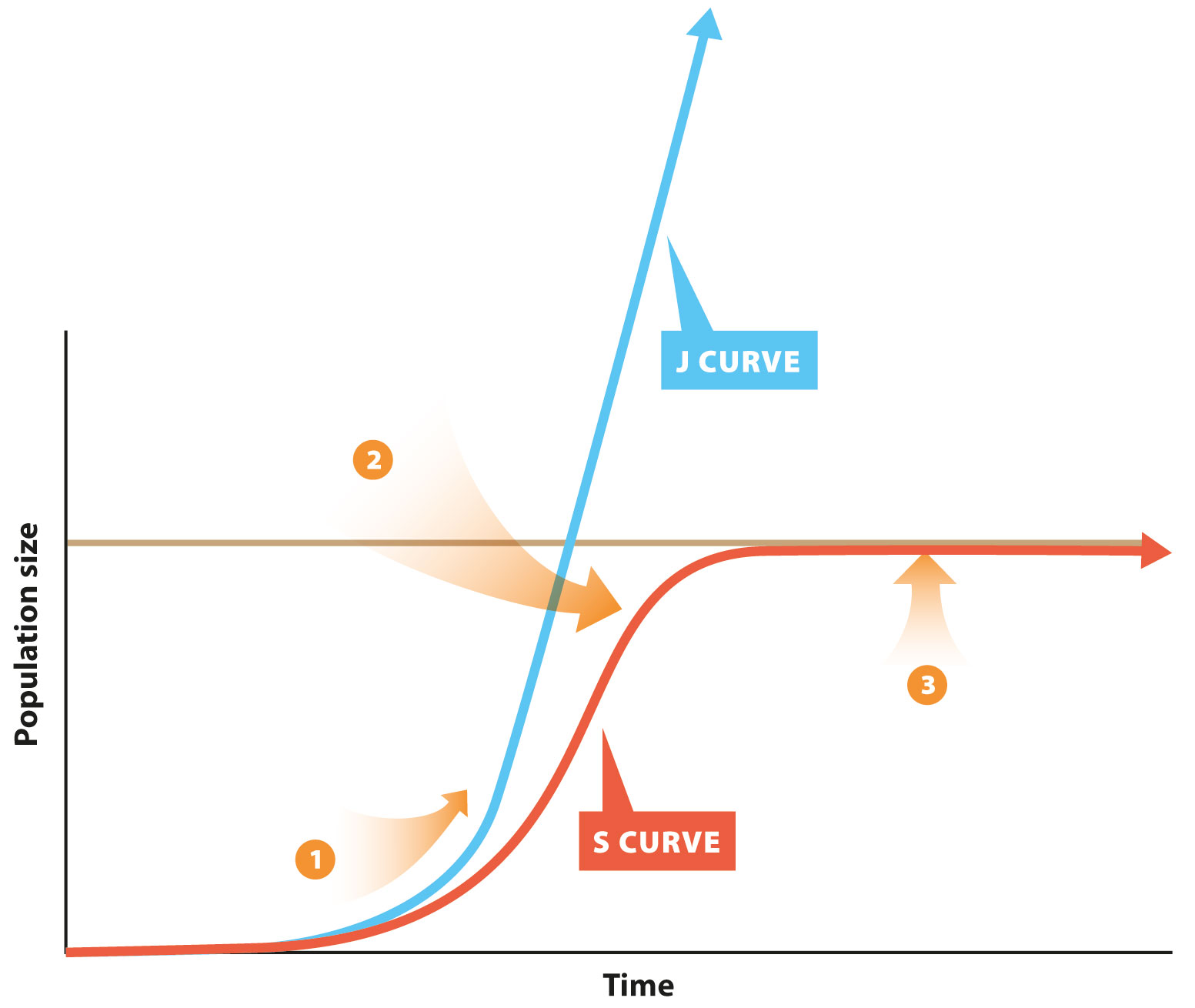Chapter 7. Chapter 7: Population Ecology
What types of population growth patterns are seen...?

Guiding Question 7.2
What types of population growth patterns are seen, and what factors affect population growth?
Why You Should Care
We have already seen the importance of studying population growth patterns in humans, and the same holds for all species. Understanding population growth and the factors affecting population size can help experts predict when populations or entire species might be at risk for extinction or when populations of "pest" organisms, such as white-tailed deer, are going to expand.
Question Test Your Vocabulary
Choose the correct term for each of the following definitions:
| Term | Definition |
|---|---|
| +20GBy3YGPJK5FM3yyw91bCvLDlvxMYNPqoWBQ2a8NLshICYkIu5qvPU1vO4VJiCPukgzo6KtxWRmemvOWQInZJEEr+2gGHw+BUcLKIc3pJE3ZaZs2s+pdsVgBQrJChA9FHVCpm810yeuG34MzIeEQ2Nk+lUbPICd+b+kP0X6YgiL+g0LE3pJLuTNC9/zAQspVcBhJlZkGI5nbVLtDX9Lev7PYf4O5Ms0IXc3vwPrYP55RjCZUwiH6qiAaSHL5xA | Factors, such as predation or disease, whose impact on the population increase as population size goes up. |
| gu2UYlffmLqUC4weCy5mmjZVuT6KrHfEew0Ndpl1FqXLpewlLdN8L8/iHZPWydxy0vD+4Fptx+5BX8juSEITomUxbtgFlPz2TzRoS0yrEZ9SzX+mKisihyDvjVjJM3I6pjzHazl661VqPgkKHXojNn8P5NZmSpbubx5lawhrW9Nup7FDYQwwe2yCPaazWUbDFEd1ypZ6HSBAoPNwT7+LXTLfXrxm03iYt8MdiHO41lnlGstlKNADaHD9bcPPNvdT | The number of deaths per 1,000 individuals per year. |
| AG4/EXpYaq0lH0J/iGY++Ejc5V6NZWQaBuQCm/5g4yymI/VBBkIlbiCucA+Ie/zYF9KzMMqDrf7zWDBfRUCa1q/El5OobL/9q+tcAeXhCyC//KhPkbzllfLeVRc5xi3LiLIe7NcAxD1Z3Y5MqxIn0DSacUNsZ8PyEKddrb+QausCyjK9CqPrYO1U1kH9O4zn74ZpDHiDpxBba6Eft/GH72YN7uoIJClqffvmj8obhlYe2pt1V8MJuD4t0MZrrRPm | The kind of growth in which population size increases rapidly at first but then slows down as the population becomes larger; produces an S curve when plotted over time. |
| u+WYZiGAkpXb91pytfxD0Fno6EUxA8S/rc2ogTEWHagxoKJzPbLhsAKYSNRsktMPZhSAVYppVyVBdc+68MySiSltacqqQE5zNxZ6XKFp2nGsZuYfc/zfTdkPfh4WFXPRGW2enQGJiy2nQUNP726oVbiGbCO49IPcuPITvZIYwIP2TjBL29hUmS0anMTOjUgfzT6X1Bn4LcsHxx801N8cY4xqPzBanLooqyugO8x/VaLCNU0kJcdbzKhnTJSiFqD7 | The population size that a particular environment can support indefinitely without long-term damage to the environment. |
| zWpTTFIPkM22KUJ35crbrcmdmD7WgE+dP83tZCo4GBmEEmmHWpyhFrX9jI+FYCsXJgokeKDP34K6XR6yyCocIzqC19hrCrHwDEXqhhoM1uZ/pmOGeXtPKvM6sb44+eVPY9R3+PDHeVgmndA6I9189o32abRFH1HIyLkVeH7Z5xbVNpC4O7/b9Wc/crkeZ/XmV4ziOO0E3N2plO6IsM8Tx9/VvmOR0/6KAYRAEe3a2QKwAHsefRgtA871Ejr9uyZH | The change in population size over time (births minus deaths over a specific time period). |
| fmh3cEp+deFYFeFxdX2VZWSlN/m8RBXWB0mivEIIsfygPZoWszS+jSCapmprIyK2JjHeAeMZ4qksLoiFeZlbX5K9F+7HqiiV4R9wmGFxv3HOtBtP/hSrG3aRETnaSHERMZUGJf9E+M4BBLBnHPlXBA/ClLxMo2TqEYV6hGZdwnj4zzrXGy8Bs9UPTzgrWHLv3Db0nEaxmmG6oQpGuTHKeumFVF1MSX3mxiBPFa9560CDP1ZhcAdgHr4NdS8CvLwA | Factors, such as a storm or an avalanche, whose impact on the population are not related to population size. |
| qxwRC/Ip8KoVN++NE5oeYhluKvfgKqysnzpd5vZ+46szb88hRmiPC/axVWPT7Mg0CJXio7aKdIxQizZGkcBu1V6XKwIuZYD2NTjHGino8g24J66hnKEWWqLIQBrSufn5ueOnBLy4CghsTKzFIIh/LjzN+l7hlZpNVt3RH7+CKXpexjkD3SPU3jq+fI9TThn6tgqEJ0Lpi/sei75VUEOrUw4yfb2z1Beuk9gwFTWzR/SPcQcBPXDs6lCKzpEq/Igp | Population size becomes progressively larger each breeding cycle; produces a J curve when plotted over time. |
| GcT/3+GOdSlLS4OdgmSU8lmBgUNuwUF3+Lu/rPU57zf8zZJS2h+0UlIyiLIHJNhbJCCON6I8pfjJk/fCMZdaa9XgwwUiBNiap0OVZ1l8eVg4qy/HJ4PUCy+hoyfozk0O3dh5auINt/4RbshgV5nQ/PT6vYsIbP7anx+bUGxFvyjLH5F8otLLvmLHJkD2MAjXtFcIwYLl1DpRSOOOpwZaRgYJGP6NuwURZvJ+Zz9WWEaWAYpc5g7p629rdatVZKCT | The number of births per 1,000 individuals per year. |
| hKLuUY0qS5Q7Bm+S/23xLd3S1AoDtwZTTFzWCQnUOJUVfESoS914TIO9Xvd9XyFgQ+Khv4ttOq6e2xYwkt4VX1bzPRRMLb81FcbK3nw/dp0kRUE+9DruemaBlk/Qz+9zLCZ9DaLfHGmDT85Q6SqDaSvoG1xJSsyvdPJ6+LuCj3ygyVZzF7NZ0LSIR4jYJIKl3+tV7F4S/Qi4NsETzabNwO16WmWlWF7C43HmZeSRZianDG/1xHlKE0i0/krso4T0 | The maximum rate at which the population can grow due to births if each member of the population survives and reproduces. |
Question 7.1
cAE1pH0Jf3EKDPZXIODwQfF4VbMgKPEwdMQw3Qmte422wKSer3TF07kCfmpjwatyUZMlpd00cLJACAg95mBqR1mPH0J6pVcs9nwsEsE+/NVzFEm6AN3YGRANUx+w7ZGF3q1FtInWNTYL8lKYiXR5625azcFPzRs/mSrms0gB7o5PLwre1gGbsgrUghR1xERTL/zILtpWyoc4v650Sc+cqt4Df5rooUzUC5RlDaE6nYV5NNhhIoNDcuNjegRtCfmalcuBrdxyay07/f7WiAx4dOgLMbvBkYqQQuestion 7.2
8kdGP8PP9XhDvch52Rm26tEiGlPSxtCe3h+QuEEs0nityK8MKTwHVu7C2iHg7VrcI4rOzCupXT8e5V7ur9qUeV9KB8hD1+Rxx4ZJCHKkZUMlWuuGGQkkM4yLVx8kj68ALv3xvpWQ0JyZIC3LVTXbr72ESPdUYXhwfSTxiKSj3+RZPH99HI0C8l7uuWDs3jF6Rtyk8UGgLrzDRUIKq+4MHh7F9Zw=The correct answer is 486.
1. 2 × 3 = 6
2. 6 × 3 = 18
3. 18 × 3 = 54
4. 54 × 3 = 162
5. 162 × 3 = 486
The correct answer is 486.
1. 2 × 3 = 6
2. 6 × 3 = 18
3. 18 × 3 = 54
4. 54 × 3 = 162
5. 162 × 3 = 486
Question 7.3
hy+Jjy2P73FZRKXuXzcVgxWR4alz/rDhFY562I1EJIK8lbwp1QFCHBkggQ8Cn2uoUZ8Rh2uofep90OFhhmA/CgR9wl4oczButOBeunAH/UXFuSO31kH36nzckpIOEVjmCm6/TQO/3LaAn18LPwdMkw==Question 7.4
wKu+iTNaRH7UFBtsktqvXlAqA+aIQpSHA++nH5Z/O+g6cF0DSl/usiCdGA4iD3/puJh8VnJuhe+LeXm0xei4igDJcxBlP+z6YFi84gC0CggTrXT743bi22KcSyQvj5P9TV4tDIRHrKblgVHrll60Lt+a6FtNsLTfViPxpYddZpIgExXVbQr6HP59zzusqiC+cTNrlJzzWcw=In the example of exponential growth in deer-mouse populations, the population starts with a single pair of deer mice and increases every breeding cycle: 2 to 10 to 50 to 250 to 1,250 to 6,250 by the fifth breeding cycle.
Question 7.5
tWDiHqC4buD7N4FqHYzaYtXCo2L//HUs4CedIoLBxM9KoEMipHVp2z4okKoptzKryr4DsBcFVe+n14ZTgAZuY41beW44biLt9Y5EV9YLx7skQIWZ81edYODqLSOnS4+JJumvpttoxn+XzEU/hNJiMKMeHW9tD1lH2KZJyghWbnE5N6n2vMTbtEW4WNZGK3/NdkBUnfU6cyQ1X8ECyo2rOXFP2UxsZLyLxfz1M6A1GPo=2 × 5 = 10
10 × 5 = 50
50 × 5 = 250
...and so on.
Question 7.6
/ye2qVKD2UkLU041JelyeF6WLqEKaAa1BYEeo6a66TC3HrHCppvXealTG9hlIKIT713OlMFAqzw62UIhR8SpIg1eQtTBIzPl8wc04PabnLvkWGNqhVilRqU4O9SmxXh1u7aMi5NwqdW+pcXBTNBfMtMHE4nYWRv/tR94ee+ft1sVOmBAtwEeUjUkNJeipOFVf8o4iuqvuwX6N98GRjyPnRnhKyiWWrJRltSBeKroyhtp2aN51. 2 × 3 = 6
2. 6 × 3 = 18
3. 18 × 3 = 54
4. 54 × 3 = 162
5. 162 × 3 = 486
1. 2 × 3 = 6
2. 6 × 3 = 18
3. 18 × 3 = 54
4. 54 × 3 = 162
5. 162 × 3 = 486
Question 7.7
I07AqndZ6LW1hPGHBRoTKCpZ2OG6jT0e4SsHluBio2/klYug5+EoIrmY8sX2h1a8vkH97TjvmXz96WfpfvESK5QdqyxO0cmzVZP5tBAGdX87R7IoqQSRPtueRkIHDFHVPUTqKcOxqpbm7m+F/PGzGLTastgbRS0FCMy+fipc3HlUTpAtcSCAe8UnGgc=Watch the animation below and complete the drag-and-drop acitivites at the end to learn about exponenetial and logistic population growth.

Question 7.8
7ScaDRy26J76rWYozEKbNkAi4Su+lE+xC7usFm0B0GvD78yFNE2Eq7Tv/amOmSeocitN+l8LOFrelwEOHzTSGiF2e5BNC7/zSbvi9y6v8sh9bysNpGyyQWbHswAOOi97u2L3f21nRdO4q0gcQlolRrjiMZz6KYuxvbqZrVnRNGekXXQdJyPV5kxa1lomZOSzwqeMPmRG8+1fvqAjUI4HAD/CqAWM5Vb+bStcSmP2eFPao77rs8ViLEjkAjPMSoTq+GBGAByQCQg=
Question 7.9
mC1c96W4Th3aHkN83YfN6GKNDovOrgzjg9OXN7VhZfcX0Vn/vxfTDYUEvl9HOoLkIT68MUV1Hz5PRYEht/jX3brMt1zwjcI2pdA9BNd2s+hzXtggMB8eAkOZPhhAjmh2Zph8bT/aosQR4HL1g0RSVj/btiFWkaxK0o2giyN8PWaiB+8Akg8vXhKQnND+5jblkmdTOhQMtOkrZKAQDjxM5LF7jr93mi/cux1xKBcG3HHbgNnaFJRVgq18D9BCAoOF0/Z4woBhww6YMG8V1ifoNUW5xcfSsM6BJ+EUWpHwrIF5vqQjr9ScWYCbzTmT1qFi5lUFYG5oX4t2YvZ/pNTHz/pB6wsnVevzIKg3iEtaL2t830utxZzNjRfK7gsHzknv/q+ZgufTtUjGX5wpkZ7IYYkLhT3FxMArhKVIvdF30F3LEMDzIpfXq1Y2X+kSZVM6dnOGDGCjsqb/t2jMNpnXqLGRh8kpCDNFdM5FAOVRp9XV98Fdd7QIV7zeacKKz5q5o3x3IqTsKz+a2ux6vqP/yWbyHzLohe8fZqCzKV77x3I=Question 7.10
zwryfKcG6Oo5BswWXvYWRTFv609qWvMC8sljXTT98N+pPGszkpS0GHf1OHnWUG+iBVzpoBuNbov6LB9sfgu+HpcBMzEDELqVqGSaTm+Hw59idw9hyGSBEmHaJB5MuBsehgfYkH5GGl6yTKjtbIi8b3+N9fddTcUjQA0wt9AmYjmDc8LW6TVwGmc+yhZpg2i3Fgskr7mCJICl5eVBh0wSkPD/fgebkjyKoZL2dllMFKq5cxowDHJiCPRmP0Y/cqJ9rhROzdzFhWE0TI4YS1SuVetPslHIuK9OLbuOlzYGqDgPmvqpS1psJoQlIWuvjij82Lxq5JlZTkWAZe8M0+K6TSW63pioHjBALzMshXCnU0Jp1IdC9qCFnilLEFEynLn7BP0Tk4aaPqvMxrbIwHv521IB0uNcialJy/eRGBqYTfUENht9nVny1Q==Question 7.11
7WV0Hff5tQeFq4F+CpWYEVhuzAyFvFEBfCKMkBIO09mFB+CeAbThLN1sThTxo07FsdgAVhppLQ/hyfN7oKaRwHjiAzfWwrgl8g10PwZBIW5QyO5EaYl3QvAYc6VQEOMcKq6EaxDVx4kF6UIw0LaGd9oPx1XpASCFgJTy1X9GqOZSGQQQK3Ffz5ugpSs5uyKPGJXmJnu7eDph5SS3Xezx/E6UYlGjPgP8qPxIagSc9HTqd8+APAgtrMO8HQqJHe71YarO49F99cguhfbmEtsgRvc3jo0/hv/KAYExGV/8JHGppfMmtdLpxZEB43DjuQIaKqrZVTdfsFv9j71WnGxWDmAludfwg2o3FUCGcGZdHs0nIX/pR84gg0XGiwLHENgz/glRjnsxzEskW/uz59njnfdBdIQ=Question 7.12
O/fYVuhDehi7bfzLxEMTv/x48O7BKd6UrsYzcoW5Z5Ky4W8r6OJZYm7R/EVtjLRxgTiw4KIhdBPRIjlmr+b2xEoKt1nKJqILcSPifsIEnCymVqjENhey3DtAK8JjLeSUMD3rWIBKIZpRorQ4MlhD3MXMvd9c2sEQPr+RcO5VKuAnVwdXbgJfUMpQfe0gyuiQtIQU6Sinb4LuFeKAE1radg==Question 7.13
Identify the following as density-dependent or density-independent factors limiting population growth and size:
Floods NpoOCTFoWXNjMLV+fWfpe6+twrHhQrY4t3sW5Z6SkqIzXzeI7RISguSoDjA=
Drought NpoOCTFoWXNjMLV+fWfpe6+twrHhQrY4t3sW5Z6SkqIzXzeI7RISguSoDjA=
Contagious diseases 7pHdx6lKqSsO0YIfUlW9/X0rAESnNyWF5jg2+9rdDZum2C+AK4CrZJFTMUA=
Fire NpoOCTFoWXNjMLV+fWfpe6+twrHhQrY4t3sW5Z6SkqIzXzeI7RISguSoDjA=
Predation 7pHdx6lKqSsO0YIfUlW9/X0rAESnNyWF5jg2+9rdDZum2C+AK4CrZJFTMUA=
Question 7.14
Thought Question: The line between density-independent and density-dependent population growth limitations is often blurry. For example, the chestnut blight that killed most of the once-abundant American Chestnut trees over a century ago seems to have been an infectious disease that spread regardless of how dense the populations were. Think about the factors below and answer the questions:
rKyry/y9i89lEjwTfMhQsJhGAeieeGnFxxiLQcVNhyWW+dfCw2kSr1ENbNBn9u1j2b/F95Aac8ntNvdda+Wzf3CHLzq8UI0v+IgH7oh1z2ofIzlTNpAxAQ== 6TUyNXO8Lr7YGA12kid7mrfJUtW+V05JH8zFetAQTL/y8y/4BLTDWTwzQCtdi/uykQqtXS+QL2FrNur4Dense populations could also be a liability in extreme cold if there are a finite number of places in which to seek shelter and some individuals have to remain exposed.
B) If most of a food source is removed for a species, it could be worse for dense populations because there is a higher demand for food from dense populations. However, if the loss of food was nearly total, it wouldn’t matter if the population were dense or not.